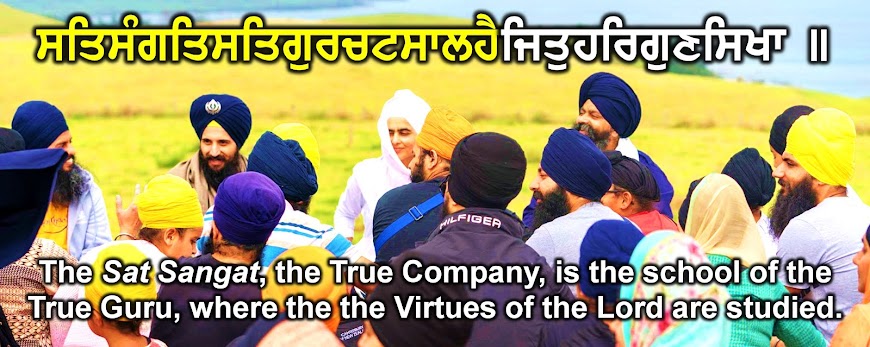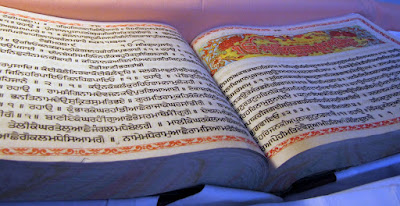Story from the Sikh Family Camp held from 22-24 April, 2016, in Denmark:
ਪੂਤਾ ਮਾਤਾ ਕੀ ਆਸੀਸ ||
ਨਿਮਖ ਨ ਬਿਸਰਉ ਤੁਮ੍ਹ ਕਉ ਹਰਿ ਹਰਿ ਸਦਾ ਭਜਹੁ ਜਗਦੀਸ ||੧|| ਰਹਾਉ ||
"O son, this is your mother's hope and prayer, that you may never forget the Lord, even for an instant. May you ever vibrate upon the Lord of the Universe. ||1||Pause||"
(Goojree M:5, 496)
At the Denmark Sikh Family Camp I met Bhai Lakhdeep Singh, his wife and young child. Bhai Lakhdeep Singh can always be seen doing seva in the Langar or Chaur Sahib seva. I had an opportunity to talk to him and find out about his journey into Sikhi.
Bhai Lakhdeep Singh has a disabled child called Kabir-jyot Singh ('Kabir' literally meaning 'magnificent', and 'Jyot' meaning 'light'). Truly, Bhai Lakhdeep Singh and his wife have accepted their disabled child as the great light in their lives which has made them see and appreciate life and Vahiguru. Kabir-jyot Singh was not born disable, but when still a baby he became ill and the hospital doctors in Punjab gave him to much oxygen which resulted in brain damage. It was inspirational to see how both Bhai Sahib and wife accepted Vahiguru's Will and do not see their child as a burden or punishment from Vahiguru, but a blessing from Vahiguru which helps them to remember Vahiguru. "Kabir-Jyot gives us so much happiness. He is the joy of our lives. He keeps us remembering Vahiguru. We are thankful we have have been given this opportunity to do his seva" said Bhai Lakhdeep Singh.
Bhai Lakhdeep Singh shared his mother had taken Amrit and was very religious minded. However, his father was not Amritdhari and drank alcohol. His mother had inspired and encouraged him to visit the Gurdwara, do Seva and instilled in him Sikh values. However, during college he got into the wrong company and ended up visiting the barber's shop. The long Kes (hair) his mother had proudly taken care of since childhood, was cut by the barber and placed into an envelope.
Bhai Sahib came home and opened the gate of the house. When his mother saw him with a shaven face and cut hair, she began crying and slapped him in the face. Slapping him on the face, she said, "What have you have! What have you done! I begged and begged the Guru to have you and now this what you have done? I went to Baba Buddha Ji's Asthaan (place) to do Ardaas to have you. O what have you done? I looked after your Kes with such love and devotion. How will I face my Guru?"
ਬਚਨ ਹੈ ਸ੍ਰੀ ਗੁਰੂ ਜੀ ਕਾ ਕਿ ਜੇ ਕੋਈ ਸਿਖ ਦਾ ਬੇਟਾ ਹੋਇ ਔਰ ਮੋਨਾ ਹੋਇ ਜਾਵੇ, ਤਿਸ ਕੀ ਜੜ ਸੁੱਕੀ,
ਔਰ ਜੋ ਮੋਨਾ ਸਿਖ ਹੋਇ ਜਾਵੇ ਤਿਸ ਕੀ ਜੜ ਹਰੀ |
“The sermon of the Guru is that if a son of a Sikh becomes ‘Mona’ (cut-haired) then his roots have dried up; and if a ‘Mona’ becomes a Sikh, then their roots have become fresh with life.
(Thankhahnama: Bhai Nand Lal Ji, p. 60)
Being young and immature, Bhai Lakhdeep Singh said that he got the envelope with his cut Kes and threw the envelope at his mother, and said, "Here have you beloved Kes. You did the Ardaas, not me. I don't care what anyone says, I am happy like this." Saying this he walked out in anger from the house.
When he came back home that night, his mother did not speak to him. Three days had passed and his mother had not spoken to and nor cooked for him. After three days, his grandmother called him over and said, "Son. Do you know that for three days, your mother has not eaten a single grain of food nor a single drop of water. This is because of you. If you want your mother to eat food or drink water, you will have to seek forgiveness from here." Knowing his mother, he knew that she had great faith and courage, and that if she had her mind set to do something she would. It was clear that the mother would happily go without food and happily die if her son had turned his back to his Guru.
Moved by the determination and suffering of his mother, he immediately went to his mother and fell at her feet. He said, "Mata Ji, please forgive me. I have made a mistake. I will never cut my hair again, but please eat some food and have some water." The mother asked, "If you promise that you will never commit the same mistake you did again, I will eat something my son." They both embraced one another.
Bhai Lakhdeep Singh said, "My mother's faith and determination gave me Sikhi. If my mother had said, "O well, youngsters are youngsters" or "these things happen" I would not be a Gursikh today. My mother's stubbornness and strict stand made me turn around. That was only time I ever allowed a barber to touch my hair with scissors."
One thing that moved him and deepened his faith again was a CD that was given to him. The audio CD was a divaan of Bhai Ranjit Singh Dhadrianwale on the Shaheedi of the Chhote Sahibzaade. Hearing the history of the Sahibzaade further strengthened his resolve to follow the Guru and seek the Guru's blessings. Keeping his Kesh and wearing a Dastaar again, he was walking in the village and came across a young Hindu boy who was his friend. He was shocked to see that he had grown his Kes, and wearing a Dastaar. He asked, "What has happened to?" The young man replied, "I have decided to become a Sikh and planning to take Amrit. Let's take Amrit together." Just as company had taken him away from the Guru, the blessed company brought him back to the Guru. Both friends went to Takht Kesgarh Sahib and received the gift of Amrit.
After Amrit, both him and his friend would everyday go the local Gurdwara and do Seva. His father became so angry with him doing Seva that he scolded him and said, "You are always at the Gurdwara. Move your bed to the Gurdwara and stay there. Get out of this house!" When the father went away, the mother would hug him and say, "Don't worry son! I will speak to your father and make him come around. Carry on doing Guru Ji's Seva and visiting the Gurdwara. Never give up on Seva or stop going to the Gurdwara. Go, and remember to come back home." His mother would always cover him and protect him whilst building up his Sikhi in front of his less understanding and non-religious father.
Despite not much education due to the circumstances at home, he got married to his wife who is an Advocate and university graduate. He asked his wife that she would have to take Amrit if they wished to get married. She accepted and received Amrit. Both of them showed so much contentment and satisfaction with life, despite the day to day challenges of life, which left a lasting impression on me.
ਸਤਿਗੁਰ ਬਚਨ ਤੁਮ੍ਹਾਰੇ || ਨਿਰਗੁਣ ਨਿਸਤਾਰੇ ||੧|| ਰਹਾਉ ||
ਮਹਾ ਬਿਖਾਦੀ ਦੁਸਟ ਅਪਵਾਦੀ ਤੇ ਪੁਨੀਤ ਸੰਗਾਰੇ ||੧||
ਜਨਮ ਭਵੰਤੇ ਨਰਕਿ ਪੜੰਤੇ ਤਿਨ੍ਹ ਕੇ ਕੁਲ ਉਧਾਰੇ ||੨||
ਕੋਇ ਨ ਜਾਨੈ ਕੋਇ ਨ ਮਾਨੈ ਸੇ ਪਰਗਟੁ ਹਰਿ ਦੁਆਰੇ ||੩||
ਕਵਨ ਉਪਮਾ ਦੇਉ ਕਵਨ ਵਡਾਈ ਨਾਨਕ ਖਿਨੁ ਖਿਨੁ ਵਾਰੇ ||੪||੧||੧੪੧||
"O True Guru, by Your Words, even the worthless have been saved. ||1||Pause|| Even the most argumentative, vicious and indecent people, have been purified in Your company. ||1|| Those who have wandered in reincarnation, and those who have been consigned to hell - even their families have been redeemed. ||2|| Those whom no one knew, and those whom no one respected - even they have become famous and respected at the Court of the Lord. ||3|| What praise, and what greatness should I attribute to You? Nanak is a sacrifice to You, each and every moment. ||4||1||141||"
(Aasa M:5, 406)


















































